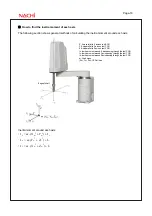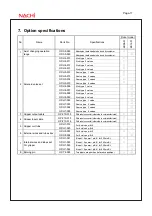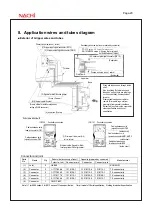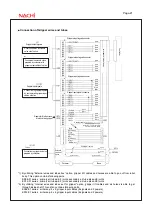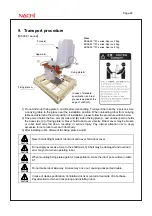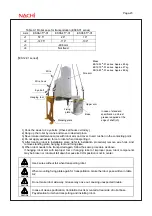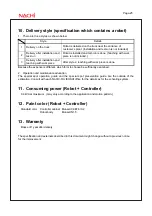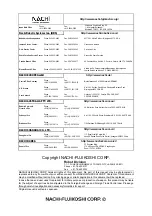
Page-11
5. Installation procedure
DANGER
Axis 1, 2 and 4 do not have brake. So arms are free to move while carrying it.
Never forget to fix arm properly when carrying robot in order not to be caught by moving
arm.
WARNING
To install the robot, it is important to position the robot so that no workers will get
pinched by the robot inside or around a device to use the robot. The robot must not come
into contact with any peripheral equipment when operating in the maximum operating
range with a tool mounted on it.
WARNING
Be sure to install the robot according to the specified procedure. Otherwise it will cause
the robot to move or topple over while in operation, thus inducing an imminent hazardous
situation.
WARNING
To make wire connections between the robot and the controller or the peripheral equipment,
fully understand the connection procedure for proper wire connections. Making wire
connections according to improper procedure will cause the robot to malfunction.
WARNING
Be sure to establish a proper ground for the robot. If equipment such as a welder that
causes substantial noises is needed to use, establish the specified ground for the
equipment.
WARNING
During transport or installation of the robot, pay utmost care not to cause damage to
wirings. Furthermore, after installing the robot, take protective measures such as using
protective guards so that the wirings will not be damaged by workers or other persons, or
forklift trucks or else.
IMPORTANT
Robot is not dust-tight packaged.
If robot is used in clean room, abrasive or fine particles shall be removed before carrying
it in clean room. It is recommended that robot should be cleaned by swabbing with
isopropyl alcohol (IPA). Use of other solvents or pure water could contribute rust or peel
of coating materials.
IMPORTANT
It is to be noted that cleanliness of robot is worse if it has operated in poor conditions for
a long time or if it has been left as it was.
■
Installation location and ambient conditions
Conditions (temperature, humidity, height and vibration) are written in “2. Basic Specifications”.
Further ambient conditions listed below must be observed.
(1) Location with the drainage structure so that swivel base is not flooded, when the liquid such
as water or cutting fluid is splashed on the robot body
(2) Location with no flammable or corrosive fluid or gas.
(3) Type D grounding (the grounding resistance is 100
Ω
or less) is necessary.


















